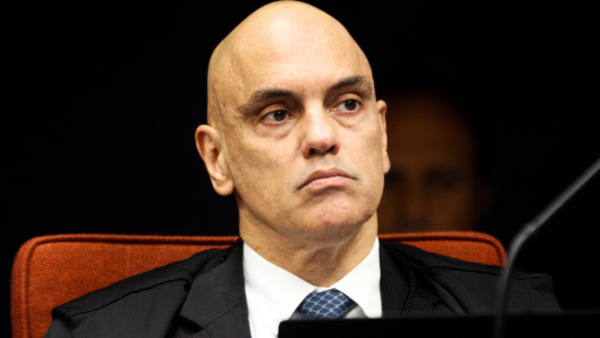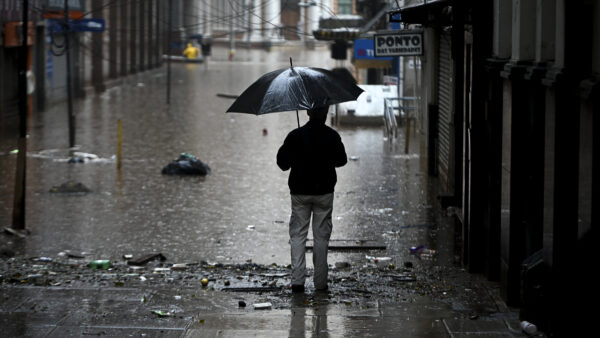In September 2023, an extratropical cyclone hit Brazil’s South region, causing heavy rains and floods and killing dozens of people. Thousands more were forced out of their homes, and city officials declared a state of calamity. Just seven months later, the region is facing similar challenges — though this time, climate events have been worse.
Early in the afternoon of April 26, the National Institute of Meteorology (Inmet) issued a warning about upcoming storms in Rio Grande do Sul, Brazil’s southernmost state. Some areas of the state would receive over 100 mm of rain over the weekend, and winds exceeding 70 kilometers per hour would cause hail.
Days later, MetSul, a meteorological monitoring company, said the state was at “severe risk” of floods and landslides due to the heavy rainfall. Roads would be blocked, and crops would be underwater.

The forecasts came true, as the state has suffered over the last few weeks “the worst meteorological catastrophe” in its history, in the words of Paulo Pimenta, a Rio Grande do Sul native and President Luiz Inácio Lula da Silva’s press secretary. Governor Eduardo Leite called the situation a “war-like scenario” and said the state is facing its “most critical moment” ever.
In the last few days of April, the state of Rio Grande do Sul has received about 70 percent of the precipitation typically recorded for an entire month. According to Ogmet, a meteorological service, eight of the ten cities where it rained the most in the world on Thursday are located in Brazil’s southernmost state.
In Porto Alegre, the state capital, rainfall in April 2024 was more than twice that of the 2001-2023 average, per data from the National Meteorological Institute.
Per state authorities, at least 1.3 million people have been affected by the floods. As of Tuesday morning, over 90 people died in the current crisis, and more than 130 were missing. Over 155,000 people had been displaced, and more than 48,000 were in shelters. Entire neighborhoods in several cities are covered in water. Last week, Mr. Leite declared a new state of calamity and was visited by Lula.
The federal government declared on Sunday a state of calamity in 336 of the 495 municipalities in Rio Grande do Sul, which helps speed up the receipt of federal funds to address the needs of areas hit by disasters. The government also authorized the payment of BRL 580 million (USD 114 million) in budgetary earmarks for hundreds of cities across the state.
In solidarity with the state, the federal government also canceled a major nationwide exam for public workers that was scheduled for the weekend. Over 2 million people were enrolled, and the new date for the exam has not yet been announced.
An ongoing Armed Forces search and rescue operation in the region has employed nine aircraft, 98 ships, and 936 troops from the Navy, Army, and Air Force. The military is also handing out water, food, and donations.
The crisis has also disrupted logistics. The international airport in Porto Alegre, the state’s capital, has been shut down indefinitely since Friday. The airport’s lobby was overtaken by water on Monday morning.
Railway operator Rumo announced a partial interruption of its activities in southern Brazil. Braskem, Latin America’s largest petrochemical group, announced a total shutdown of its operations in the city of Triunfo, and major steel producer Gerdau also announced an indefinite shutdown in the state.
The U.S. Consulate in Porto Alegre announced it would be shut down for visa interviews on Monday and Tuesday.
A long time in the making
Climate tragedies seem to have grown increasingly common — whether caused by extreme droughts, massive wildfires, or torrential rainfall. Last year alone, Brazil recorded almost 1,200 such events.
And despite the concerning scenario, Brazil has invested less and less in disaster prevention policies. This year’s federal government funding for disaster prevention and response is the lowest in the last 14 years.
For 2024, officials in Rio Grande do Sul approved a state budget providing 7.5 percent less money for disaster mitigation services — and none of the state’s lawmakers used their budgetary earmarks to pay for environmental conservation services.
Meanwhile, news website Uol showed that City Hall did not invest a single dime in flood prevention in 2023, and expenses had already dropped in the two previous years.
The federal government, for its part, has failed to make good on its promise of a powerful Climate Change Authority 17 months into the Luiz Inácio Lula da Silva administration.
The truth is that authorities have largely ignored the alarm bells sounded by researchers. In 2015, a study commissioned by the federal government warned that the country may face dramatic climate conditions by 2040.
Violent droughts may prevent hydroelectric plants from generating enough power — which would make billion-dollar investments in dams in the Amazon futile. Crops such as soybeans could see a reduction of up to 39 percent in their area. Rising sea levels will expose real estate worth up to BRL 124 billion to a high risk of destruction in the city of Rio de Janeiro alone. More elderly people will die from heat waves, especially in the North and Northeast regions.
The study was published without fanfare — and largely ignored since.
Porto Alegre was preparing to embark on the final phase of preparing its climate action plan, which has been in development since last year and was scheduled to be delivered in July (parts of it are available on City Hall’s official website).
The descriptions and risk projections that the plan makes for the future are almost a perfect portrait of what is happening today in the capital of Rio Grande do Sul. (See below a map of areas under flood risk in Greater Porto Alegre.)
Fernando Mainardi, a professor at the Federal University of Rio Grande do Sul (UFRGS) with a Ph.D. in Water Resources and Environmental Sanitation, told The Brazilian Report that the current infrastructure in Porto Alegre, comprised of dikes and pumping stations, is supposed to contain a level of up to 6 meters in the Guaíba River, more than the around 5.20 meters the river reached by Monday.
However, probably due to a lack of maintenance, the system failed — leaving neighborhoods such as Cidade Baixa, a famous nightlife hotspot, under water.
“The system should be enough, but it failed at several points,” he said. Other experts interviewed by local paper Matinal also said that a lack of upkeep and investment contributed to making the flood much worse than it should have been. Pumping stations failed, and one floodgate burst.
The infrastructure was built in the 1970s, decades after a major flood in 1941, the worst in the city’s history until it was surpassed a few days ago — despite the dikes.
Mr. Mainardi spoke to The Brazilian Report by phone as he watched the water levels rise in his neighborhood in the city’s East Side and had to interrupt the interview.
Antonio Eduardo Giansante, an engineer and professor at the Mackenzie Presbyterian University, said that Brazil counts on enough technical expertise to prevent disasters, but political leaders are more interested in inaugurating new public works as opposed to keeping and running those that already exist.
He added that Porto Alegre — a city of 1.3 million people — was developed in an alluvial plain, a mainly flat land area adjacent to a body of water, and thus subject to floods.
The flood was of an unprecedented magnitude, he said, underscoring the need for prevention and mitigation of future extreme climate events.
Mr. Giansante also drew attention to the fact that evacuation alerts are not very helpful if people are told only to leave their homes and not where to go. “An alert is not just a siren going off,” he said. “The population needs to know where to go, what actions to take, and how much time they have to do it.”
Federal telecommunications agency Anatel announced a new emergency alert system in March 2023, but it has not been launched yet. The Regional Development Ministry and the Communications Ministry did not reply to our questions about the system.
Regional Development Minister Wáldez Goes said last month, after a series of floods in the southeastern state of Espírito Santo, that the system was coming soon, but made no further announcements. Anatel told The Brazilian Report that it carried out tests with major telecom operators Claro, Tim, Vivo, and Algar, but that implementing the system requires training and planning from city and state authorities.
Porto Alegre Mayor Sebastião Melo asked residents to leave the city on Sunday, as 85 percent of residents have had their water supply cut off. “We need to reduce circulation in Porto Alegre so that rescue services can reach the right place more quickly”, he said. “For those who have a beach house and are able to leave Porto Alegre, I recommend that you leave and go to the beach”. Few people can comply with the suggestion.
Mr. Giansante concluded: “Unfortunately, Brazil is showing the world that we need policies to adapt and mitigate extreme weather events.”

 Search
Search










































